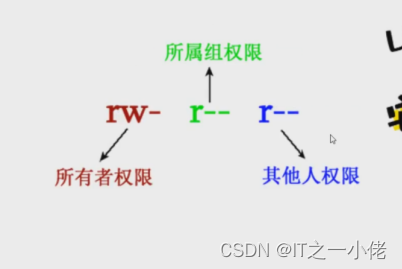| Linux系统中文件基本属性之ls命令详解 | 您所在的位置:网站首页 › ls-r什么意思 › Linux系统中文件基本属性之ls命令详解 |
Linux系统中文件基本属性之ls命令详解
|
1、显示文件属性
Linux可以支持长达256个字符的文件名称,且文件名是区分大小写的,"abc”与"ABC"所代表的是不同文件。 1.1 文件类型
文件类型: 普通文件(-):存放数据、程序等信息的文件,一般为文本文件和二进制文件。目录文件(d):文件系统中一个目录所包含的目录文件,包括文件名和子目录名。链接文件I):可以在不同的文件系统之间建立链接关系来实现对文件的访问。设备文件(c):把IO设备映射为一个设备文件。管道文件(p):主要用于在进程间传递数据。 1.2 文件权限所谓的文件权限,是指对文件访问权限,包括对文件的读、写、删除、执行操作。Linux是一个多用户操作系统,它运行多个用户同时登陆和工作,因此Linux将一个文件或者目录与一个用户和组联系起来。 每项信息说明:
文件设定不同用户的读、写和执行权限,仅涉及到9位字符。 Linux系统中,文件有三种访问权限: 读(r)-允许读取文件写(w)-允许写、修改和删除某个文件执行(x)-允许执行某个文件 2、ls命令选项使用Linux ls(英文全拼: list files)命令用于显示指定工作目录下之内容(列出目前工作目录所含之文件及子目录)。 语法: ls [参数] 命令选项说明-l以列表方式显示-h以大小单位显示,默认是字节-a显示隐藏文件和隐藏目录参数: [root@192 dgw]# ls --help 用法:ls [选项]... [文件]... List information about the FILEs (the current directory by default). Sort entries alphabetically if none of -cftuvSUX nor --sort is specified. Mandatory arguments to long options are mandatory for short options too. -a, --all 不隐藏任何以. 开始的项目 -A, --almost-all 列出除. 及.. 以外的任何项目 --author 与-l 同时使用时列出每个文件的作者 -b, --escape 以八进制溢出序列表示不可打印的字符 --block-size=SIZE scale sizes by SIZE before printing them; e.g., '--block-size=M' prints sizes in units of 1,048,576 bytes; see SIZE format below -B, --ignore-backups do not list implied entries ending with ~ -c with -lt: sort by, and show, ctime (time of last modification of file status information); with -l: show ctime and sort by name; otherwise: sort by ctime, newest first -C list entries by columns --color[=WHEN] colorize the output; WHEN can be 'never', 'auto', or 'always' (the default); more info below -d, --directory list directories themselves, not their contents -D, --dired generate output designed for Emacs' dired mode -f do not sort, enable -aU, disable -ls --color -F, --classify append indicator (one of */=>@|) to entries --file-type likewise, except do not append '*' --format=WORD across -x, commas -m, horizontal -x, long -l, single-column -1, verbose -l, vertical -C --full-time like -l --time-style=full-iso -g 类似-l,但不列出所有者 --group-directories-first group directories before files; can be augmented with a --sort option, but any use of --sort=none (-U) disables grouping -G, --no-group 以一个长列表的形式,不输出组名 -h, --human-readable 与-l 一起,以易于阅读的格式输出文件大小 (例如 1K 234M 2G) --si 同上面类似,但是使用1000 为基底而非1024 -H, --dereference-command-line follow symbolic links listed on the command line --dereference-command-line-symlink-to-dir follow each command line symbolic link that points to a directory --hide=PATTERN do not list implied entries matching shell PATTERN (overridden by -a or -A) --indicator-style=WORD append indicator with style WORD to entry names: none (default), slash (-p), file-type (--file-type), classify (-F) -i, --inode print the index number of each file -I, --ignore=PATTERN do not list implied entries matching shell PATTERN -k, --kibibytes default to 1024-byte blocks for disk usage -l 使用较长格式列出信息 -L, --dereference 当显示符号链接的文件信息时,显示符号链接所指示 的对象而并非符号链接本身的信息 -m 所有项目以逗号分隔,并填满整行行宽 -n, --numeric-uid-gid 类似 -l,但列出UID 及GID 号 -N, --literal 输出未经处理的项目名称 (如不特别处理控制字符) -o 类似 -l,但不列出有关组的信息 -p, --indicator-style=slash 对目录加上表示符号"/" -q, --hide-control-chars print ? instead of nongraphic characters --show-control-chars show nongraphic characters as-is (the default, unless program is 'ls' and output is a terminal) -Q, --quote-name enclose entry names in double quotes --quoting-style=WORD use quoting style WORD for entry names: literal, locale, shell, shell-always, c, escape -r, --reverse 逆序排列 -R, --recursive 递归显示子目录 -s, --size 以块数形式显示每个文件分配的尺寸 -S sort by file size --sort=WORD sort by WORD instead of name: none (-U), size (-S), time (-t), version (-v), extension (-X) --time=WORD with -l, show time as WORD instead of default modification time: atime or access or use (-u) ctime or status (-c); also use specified time as sort key if --sort=time --time-style=STYLE with -l, show times using style STYLE: full-iso, long-iso, iso, locale, or +FORMAT; FORMAT is interpreted like in 'date'; if FORMAT is FORMAT1FORMAT2, then FORMAT1 applies to non-recent files and FORMAT2 to recent files; if STYLE is prefixed with 'posix-', STYLE takes effect only outside the POSIX locale -t sort by modification time, newest first -T, --tabsize=COLS assume tab stops at each COLS instead of 8 -u with -lt: sort by, and show, access time; with -l: show access time and sort by name; otherwise: sort by access time -U do not sort; list entries in directory order -v natural sort of (version) numbers within text -w, --width=COLS assume screen width instead of current value -x list entries by lines instead of by columns -X sort alphabetically by entry extension -1 list one file per line SELinux options: --lcontext Display security context. Enable -l. Lines will probably be too wide for most displays. -Z, --context Display security context so it fits on most displays. Displays only mode, user, group, security context and file name. --scontext Display only security context and file name. --help 显示此帮助信息并退出 --version 显示版本信息并退出 SIZE is an integer and optional unit (example: 10M is 10*1024*1024). Units are K, M, G, T, P, E, Z, Y (powers of 1024) or KB, MB, ... (powers of 1000). 使用色彩来区分文件类型的功能已被禁用,默认设置和 --color=never 同时禁用了它。 使用 --color=auto 选项,ls 只在标准输出被连至终端时才生成颜色代码。 LS_COLORS 环境变量可改变此设置,可使用 dircolors 命令来设置。 3、操作效果展示图 3.1 ls -a显示所有文件及目录(.开头的隐藏文件也会列出)。
除文件名称外,亦将文件型态、权限、拥有者、文件大小等资讯详细列出。
【ls -l -a -h 可以这样使用,也可以这样使用:ls -lah 没有顺序要求】 3.4 ls -R若目录下有文件,则以下之文件亦皆依序列出。
-A同-a,但不列出"."(目前目录)及".."(父目录)。
将文件以相反次序显示(原定依英文字母次序)。
将文件依建立时间之先后次序列出,默认。 3.8 ls -F在列出的文件名称后加一符号;例如可执行档则加“*",目录则加""/"。
|
【本文地址】
公司简介
联系我们















